As a follow up to my post on soil ingredients (click here….now!) here are my soil composition percentages and sifting techniques.
Remember, though, that this soil is what works for me. It also works for many others out there but there are some so-called professionals out there that will poo-poo this mix.
Let ’em. Between you and I; I have soil for sale, but I don’t try to sell my soil. If you get my meaning?
And then there are those snobs who just must use what is traditional and correct or what all the Japanese Masters use…..phaugh!
If you read my last soil Epic you’ll remember that the particle is less important than the characteristics you need. So,if you’re using DE granules from NAPA auto parts and that works for you, then continue to do so.
To put it simply, I use what has become the standard Florida mix, but with my own percentages.
I use red lava (scoria), calcined clay (Turface brand) and pine bark (Fafard Organic Soil Conditioner). The mix is 50% lava, 25% Turface and 25% Fafard.
I’ll tell you why later.
This is my secret method…..don’t tell anyone, shhhhhh.
First I spread the pine bark on a tarp to dry in the sun (for my New England readers that’s a tahp)
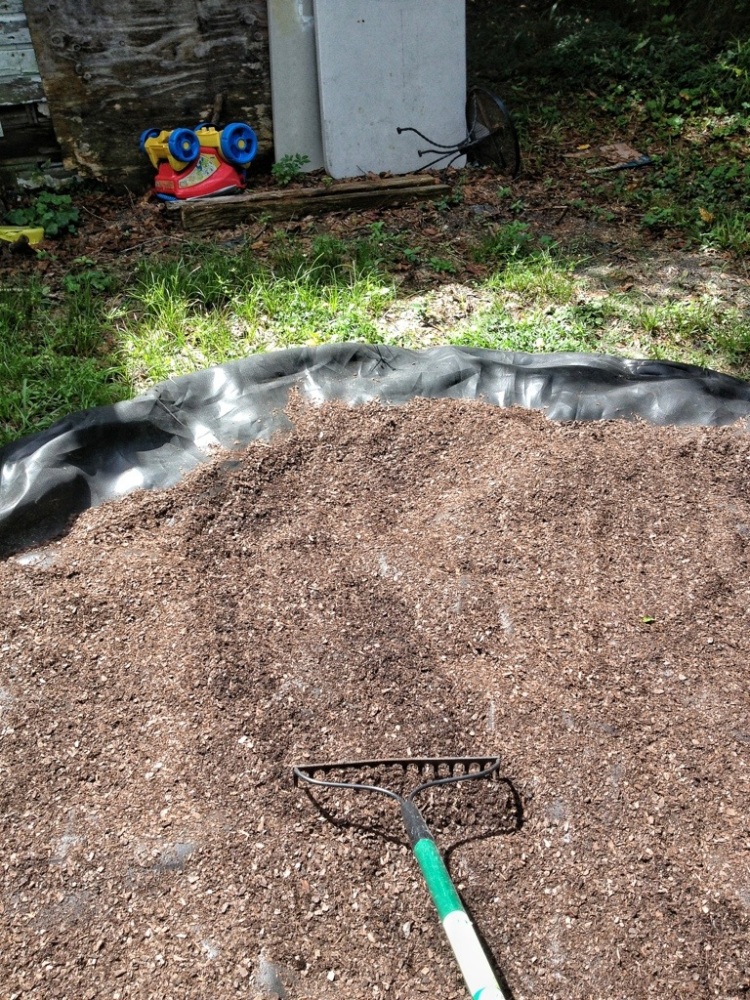
Needless to say, it should be a sunny day. This drying is important because if you don’t, the dust will stick to the larger, desirable particles and it will ultimately clog the drainage screen.
As the bark dries (which requires multiple raking and turning the wet bark to the sun) I actually wash the lava
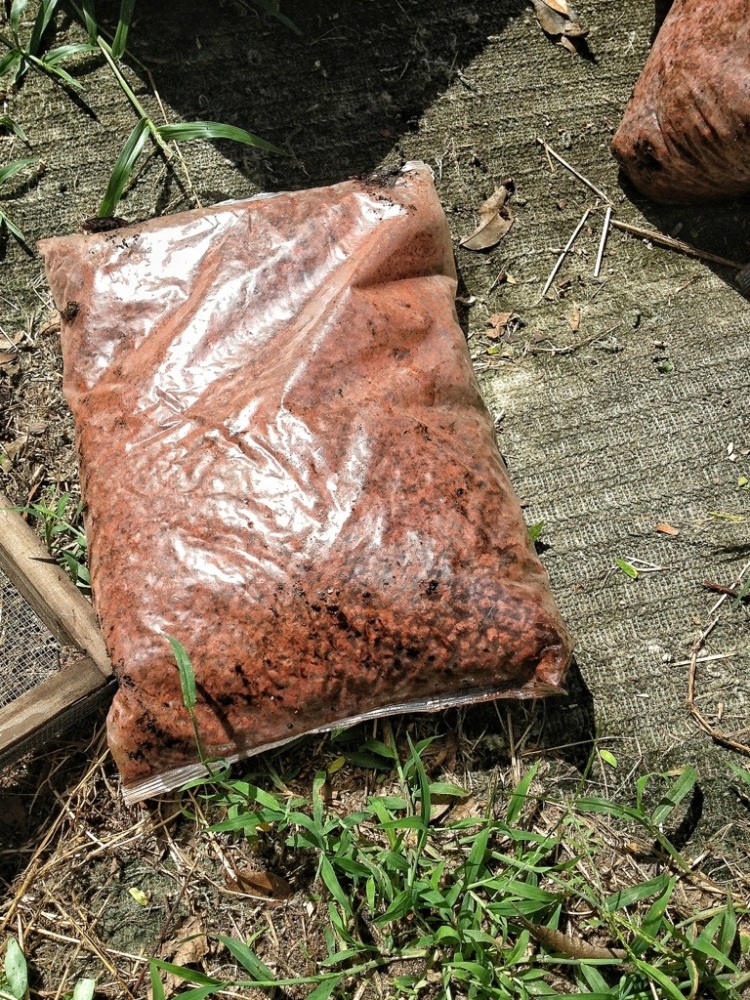
I know, dry the bark, wash the lava. It’s much easier to wash out the dust (there are few particles that are smaller than that 1/8 inch size to sift out) than to dry it and sift. Plus it’s healthier for your lungs.

This is a screen sifter I made.

You can see all the fine dust that needs to be washed away.
Just keep flushing it until the water runs clear.

“You’ll ruin your watershed Wonka!”
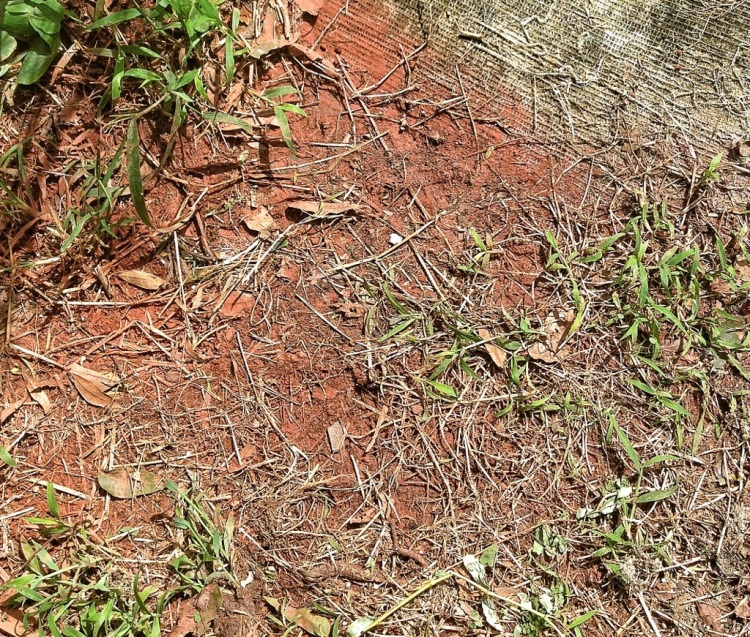
Imagine all that red gunk clogging your drainage hole (there’s a joke there)
So I set all the lava aside to drain (you can dry it in the sun now if you have all day. My friend Erik does that.) and now it’s time to sift the Turface.
It comes in a 50 lb bag and after sifting you will only have about 35-40 lbs of usable product.
I used to use one of these
Now I use The Machine.

I made this all by my lonesome.
This is a YouTube video showing it in action.
It’s very handy. I can sift soil very quickly. Faster than you can 😜”neener neener neener!”
Ok. Sorry.
Anyway, I can get through the whole bag in about five minutes.
It’s very sexy.
Just look at Dave
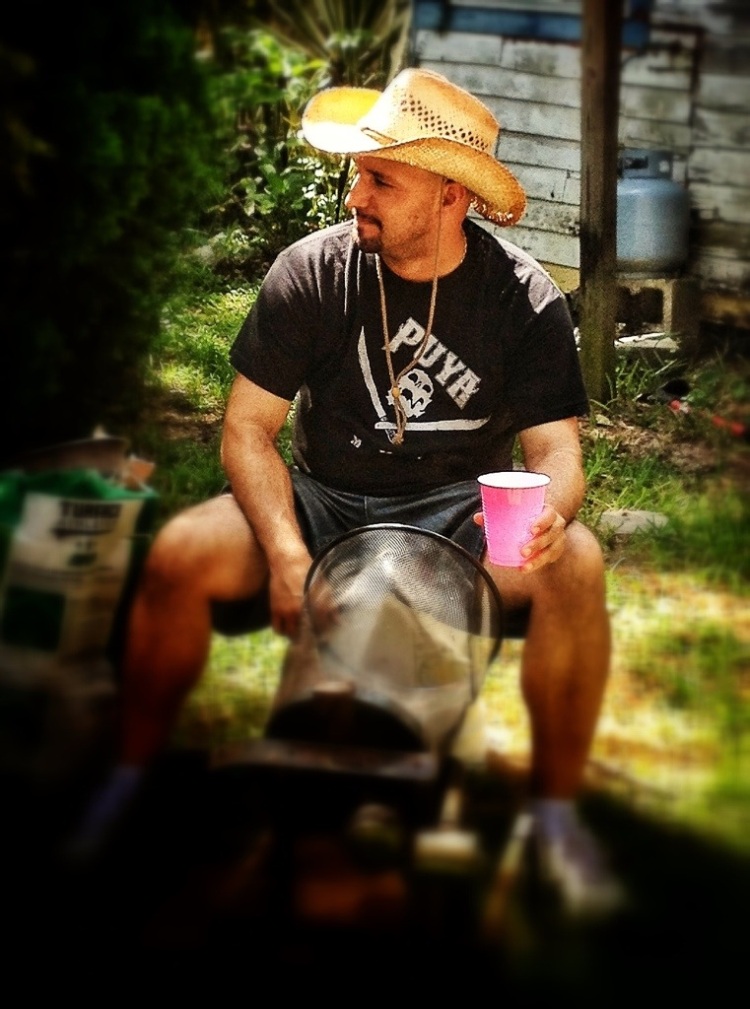
I got a call from his wife about this pic; it seems that all my lady readers are contacting him (its posted in the pictures section) and some of my male readers too (prints are available for $10, send a SASE to me with a check or money order)
After all the sifting we get this

And after mixing I end up with this
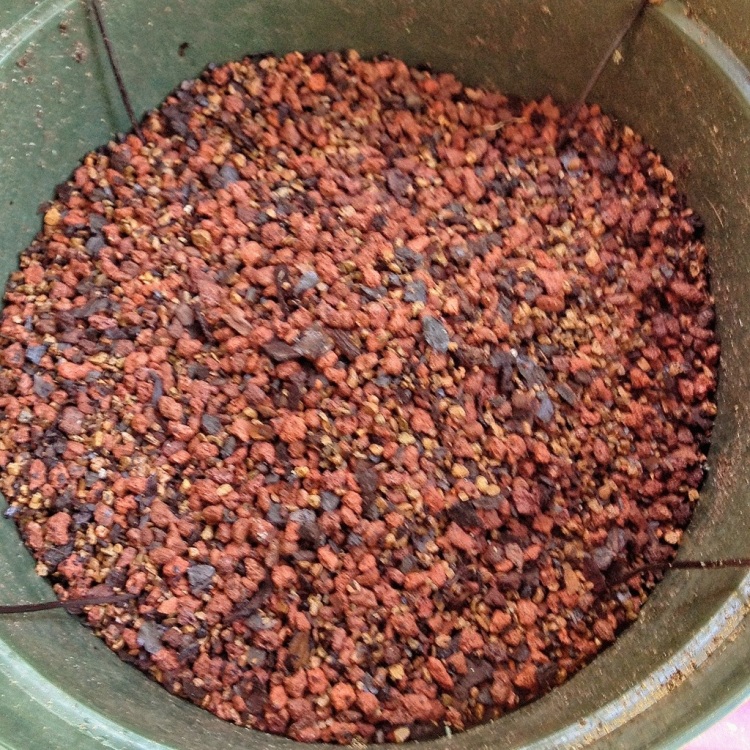
So the question is: Why do I use the percentages I use?
When I put a tree into bonsai soil I do so for a few reasons.
If its going into a bonsai pot the only reason is drainage. This mix, in Florida, will last all day in the Florida sun. In the summer, our rainy season (when it could rain every afternoon after all day heat and sun) the mix drains freely. Keeping just the right amount of water within itself for the trees health.
The lava I get is the correct size and shape for root developement.
I use the Turface for its high C.E.C. and it’s water retention capabilities.
The pine bark has the highest C.E.C.
has great water retention and, importantly,the pine bark is a differently shaped particle, which keeps the mix less uniform and more airy. The roots need air and water to grow. The pine bark breaks up the uniformity of the other two particles and keeps it from compacting. It’s almost spongy.
If I’m using bonsai soil in a deeper training pot, the reason is pure development. I will have to watch the watering more (a deeper pot drains quicker. Keep that in mind! The shallower the pot, the slower water drains and the better chance of root rot.) but it will allow the roots to grow better and push the tree faster.
My mix works for me (I can’t stress that more. My watering habits, my microclimate, and my pruning frequency). That doesn’t mean I’m not experimenting with other mixes.
I recently bought a bag of mixed soil from Japan (akadama, pumice, black lava and river rock) that I’m using on some junipers.
My friend Nick found a cheap source of expanded shale I’m experimenting with on trees that need less water (bougies and such).
I did get some of the DE granules from NAPA and I’m experimenting with that.
Probably the best reason I use this mix is……aesthetics.
This is art, after all.
And I think it’s purty.
My best advice to you: find out what longtime bonsai growers in your area are using. Try their mix but, ultimately, you’ll have to develop your own.

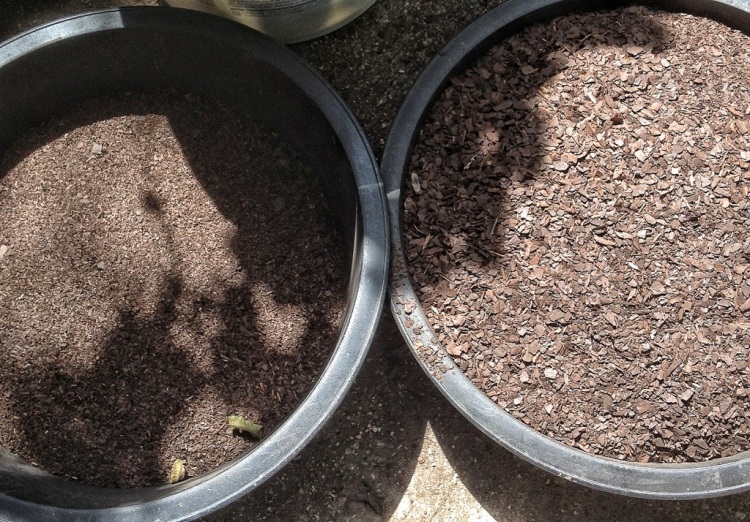
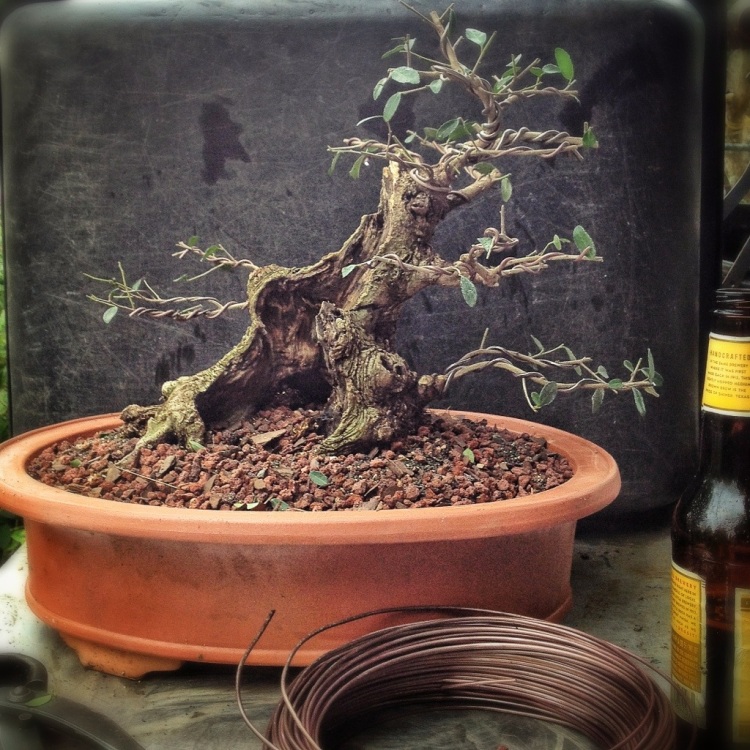
As a beginner bonsai enthusiast about to make my first batch of soil I found this entry VERY helpful. Thanks!
LikeLike
Thank you for reading and commenting. It’s nice to know that what I’m writing is helpful
LikeLike
You do such interesting work. Thanks.
LikeLike
Thanks Joan!
LikeLike
So I’m trying your recipe right now. About what size range of particles is right?
LikeLike
I don’t use anything below 1/8 inch or bigger than 1/3 of an inch. I like different sizes mixed throughout the pot. I don’t layer them from big to little
LikeLike
Is that trummel made from a waste bin? If you ever have the chance a quick video showing a walk around of the ‘Machine” would be great!
LikeLike
It is a waste bin. The Machine is basically a motor with a holder that the trash can attaches to. Pretty simple. It is 12volts dc as well.
LikeLike
Glad I ran into this one. This must be your mix before you started using the haydite/expanded shale. I hope it’s still a good recipe. And a nice rotary sifter, too – my flour sifter (extra large) is beginning to put a real strain on my wrist. 🙂
LikeLike
It’s still a good mix. I just added one part expanded shale because it became available.
LikeLike
Still one part pine bark?
LikeLike
I still use pine bark
LikeLike
There are worse things to be addicted to.
LikeLike
Thanks, for all your posts on soil. I learnt a lot. There is still one thing I am not clear:
Although bark has best CEC and highest water retention, I can understand that a soil 100% bark would not work. So here comes the turface (second best choice). But why cannot you use a mix 75% turface 25% bark for example? What is the added value of the lava? Is it to have some grains with different shapes and so increase the amount of air in the mix?
Same thing about the shale: no water retention and no CEC. So is it for having more air in the mix? or maybe less water?
LikeLike
You’ve answered your own questions. More air, less water retention, different particle shapes etc.
You can use granite chips for that matter if you can find it, or chicken grit even.
LikeLike
Wanted to let you know that I found a local who was happy to order in some of the Espoma Soil Perfector (aka expanded slate) for me. Only a 20# bag and the contents didn’t need to be sifted or graded – already pretty much the perfect size. Thanks for the tip – a good product.
LikeLike
Thanks for this information, it just reaffirmed what I’ve learnt so far in my short time as a bonsai apprentice (2 years). I live in Mexico in an arid zone, I guess we should have more sun than you do whith less humidity of course. I’ve been using a mix of 70% of lava rock (is pretty easy to find and really cheap, like 4 liters for 2 dollars), 20% of pine bark and 10% of peat moss which has worked just great in one of my experiments and which I’ll use as my standard mix from now. Do you have any experience using peat moss in your mixes? Thanks again and great job!
LikeLike
Peat moss in my wet climate doesn’t work well at all. It breaks down fast with the heat/rain cycle. If it gets too dry before watering it will repel water.
LikeLike
*Thanks, am forwarding this on to club members. Joan*
LikeLike
All the stuff you mentioned is not easily available in India… could you give your opinion on ..Coarse River Sand, Coarse Bricks Crush and Coco Chips(Coconut Husk Chips)
LikeLike
The first two components are ok, they won’t hold much water or nutrients at all but as long as you soft out the fines you’ll be good.
Coco husk is a different matter. It has a tendency to leach magnesium from the plant so you have to use a supplement when using it. Try using just compost, sifted of course or commercially available potting soil. In the absence of an organic component, or a soft clay or pumice that the root hairs can attach to (and hold nutrients) your soil will be incomplete.
LikeLike
Thanks… Here in India all compost available available is in very fine form (Vermiompost), one more option is available is cow dung manure.. but that also not much coarse … if I want to use COCO chips how it can be used (do and don’ts) or can I use fine (less than 1-2mm) particle size vermicompost or cow dung manure?
LikeLike
You want to have about 3 mm size and above. It may take sifting out a lot of the finer particles. I use pine bark and I will lose half of the product I buy after sifting.
LikeLike
Important question are you same soil recipe during training of bonsai (Training pot?) and bonsai pot?
LikeLike
Thanks .. Secondly can you elaborate on,.. if I want to use COCO Chips as organic content in soil what kind of supplement I should use.. which you mentioned in replay, or what should I do to use coco chips so that it shouldn’t harm the plant?
LikeLike
Important question are you using same soil recipe for training of bonsai (Training pot?) and bonsai pot?
LikeLike
If you use coco chips you have to add magnesium regularly to the tree.
A training pot is just a bigger bonsai pot than you’d use when the tree is developed. So you would use bonsai soil. If you are trying to grow out a tree you use a standard nursery soil in a nursery container.
LikeLike
Thanks Adam for your patience … what is source of magnesium? I am growing my tree should I use bricks crush + coarse sand + semi fine cow dung manure or vermi-compost?
LikeLike
That mixture sounds fine. For magnesium, the easiest way to give it to the plants is in Epsom salts.
LikeLike
Does it means ..it should soak in Epson Salt solution overnight and rinse it again .. and then mix it with soil?
LikeLike
No, sprinkle about a one tablespoon over the soil surface and water in. And about once a season you can apply a foliar spray to the plant. Mix two tablespoons to a gallon of water and spray the leaves.
LikeLike
Got it … thanks ..Adam … tomorrow I am re-potting my ficus with this soil mix (Sand, Bricks, COCO Chips ..(Because I do not have coarse organic material other than COCO Chips)) and follow the steps below
1. Soak COCO CHIPS in water overnight… rinse it in morning let it dry for the day
2. Next day mix 1/3 1/3 1/3 sand:bricks crush and add extra table spoon bone meal
3. Re Pot the plant …. and as per you sprinkle a tablespoon of Epson Salt over it and water it.
Will it be ok
LikeLike
Where do you all source your materials from in Florida? I am having zero luck in Polk County finding anything in the proper size. Turface is nowhere to be found, although I can buy bags of large lava rock and crush it by hand. Pine bark is generally too large, and I can’t see how to crush it to size, but I may be able to get some fines from a wholesaler or sift it at his site and buy the size I want.
LikeLike
Hi Matt
I get my lava rock from wigerts bonsai and everything else from a company called BWI. They’re in Apopka. The pine bark fines are made by Fafard and the product is called Organic Moisture Control.
LikeLike
Hi Adam, I see that wigert sells a soil of equal parts lava, turface and pine bark.
Different than your mentioned mix.
So I Wouldn’t have to buy from several different sources what is you thought on that mix?
Also if I ended up buying the seperate ingredients do you have part numbers or more specific item names.
I searched for fafard organic moisture control at bwi’s site and a handful of results appear.
Thanks.
LikeLike
Hi Tony,
Erik’s mix is a good mix for general bonsai use, no worries getting it.
LikeLike
Hello, i have a question about the pine bark used. Why specifically pine? Could redwood or even cedar chips be used instead? Of course in the correct size?
LikeLike
Hi Atom, I use pine because that is what’s regionally available. There are many people that use fir or redwood because. The partially composted component is best of you can get it.
LikeLike
Adam, just going through the soil articles again.
Looking at the BWI website the closest product I could find for the Fafard is this.
Would this be the correct item? Links to this just go to the catalog.
This would be used in place of straight pine bark?
What amount should I expect to pay for this item?
Item #: FAOSC35
Item Title: FAFARD ORGANIC SOIL CONDITIONER
Item Name: ORGANIC SOIL COND 2 CF
Sub-Title: 40 QT
Description: For gardeners who want to add organic matter into their existing topsoil, try Fafard’s Organic Soil Conditioner for healthier plants. It’s formulated to hold moisture, break up hard, dense soils, and stimulate a plant’s roots. “The Water Keeper” is excellent for top dressing, seeding, or renewing your lawn. This easy and economical approach to soil enrichment loosens hard clay by loosening the stiff structure and improves sandy soil by making it able to hold more moisture. Our formula contains processed pine bark, limestone, and gypsum.
Also the Napa product #8822 would be used in place of Turface?
I’ll give BWI a call but ask you first.
Is BWI a walk in place or will they only deliver?
Looks like the closest would be in Apopka.
I guess I’ll substitute Gravel from Petsmart until I can manage red lava.
Thanks Adam.
Tony.
LikeLike
That is the correct Fafard product.
And try the Espoma Soil Perfector for a lava substitute. You can get it from BWI as well.
The Napa product could be used in place of turface, if they have it. I have heard that it’s been discontinued. O’Reilly auto parts stores have a good diatomaceous earth product as well.
I would call ahead to make sure they have everything in stock but it has a storefront you can walk in and just get what you need.
Keep us updated as to the availability from the different places. Thanks!
LikeLike
Ok update.
Both Napa and O’Reilly’s websites have the talked about DE product listed as available.
I didn’t stop in to check becasue I didn’t need to because BWI
As for BWI WOW!!
I bought
2 bags of the Espoma Soil Perfector
1 fifty lb bag of Turface
2 Bags of Fafard conditioner
These 5 bags were less than $50 out the door.
Walmart sells the Ospoma for about $23 for 1 bag
$11 at BWI
The Turface substitute or DE range from $11 – $18 for approx 25 pound bags at Napa or O’Reilly
10.23 for 50 pounds of Turface at BWI
Fafard I didn’t check anywhere else.
$7.00 for a 2cf bag at BWI
Yikes!!
I feel like I won a prize with those prices.
Credit to Adam for mentioning the products and BWI as a source.
LikeLike
Adam, do you recycle or reuse your older soil after repotting leaves you with a pile? It seems a shame to throw it away or use it for fill dirt in the yard. I know the old could be washed and sifted again, but I was wondering if you think it might be contaminated in some way. Thanks
LikeLike
I do reuse the old soil. I totally dry it and sift out the fines. That’s one of the best ways to build the microbial environment in your pots. People don’t often think of the microscopic creatures in soil beyond mycorrhizae for pines but every tree needs them, as well as bacteria, for healthy trees.
If a tree is sick though, don’t use the soil again.
LikeLike
Adam I should have made sure when I picked up the bags but I’m not certain if the Fafarl is the correct item. I have the correct item # on the invoice but the bag looks nothing like what is in the web site and the bag has no marking indicating item number or what the contents are or at least that I could see.
Is this what I wanted?
//s.imgur.com/min/embed.js
Guess pics can’t be embedded?
LikeLike
They changed the packaging recently, I believe it’s even bigger actually.
LikeLike
Adam a question for the sifted pine bark.
I have a lot of that dust like stuff that came from the pine bark.
Do YOU use this for anything?
LikeLike
The only good use for it is to fill holes in the lawn or make compost. Don’t use it in a potted plant, it’s too fine and doesn’t allow for enough oxygen for the roots
LikeLiked by 1 person
That’s what I figured. Thanks.
LikeLike
What kind of soil you will prefer to recommend for pre-bonsai or Training bonsai material in region like India where min temp is 20 and max May go up to 45 deg C
LikeLike
For trees in training situations, meaning deeper and bigger pots, you can use more organic materials like pine or fir barks or compost.
I use, variously, a commercial potting soil mixed half and half with my potting soil.
LikeLike
Of course i’m having an issue finding the “calcined clay (Turface brand)”. But I see some of it as Kitty Litter.Is this worth using? And if so what brand do you recommend?
LikeLike
If you can find it plain, no additives or fragrance it would be OK to use. But I haven’t really tested any brands. I’ve heard that the Tesco brand in Europe and the U.K. Are good. Other than that I don’t know. Sorry
LikeLike
I found turface MVP at an irrigation company locally in Augusta, GA. Turface is also used it on baseball fields, so you may try recreational departments too.
LikeLike
Hi Adam, wonderful article, I am following your advice and am experimenting with different mixtures of soil. I have added some pine bark, diatomaceous earth, granite and vermicompost, to retain a little moisture and provide nutrients, because in here in Bogota, the air is very dry and hard to get organic fertilizers, non vermicompost . I think this article is excellent, to demystify bonsai soil.
LikeLike
Gidday Mate,
I am 70 yrs old and have been around a bit I even went Cleveland for my work some time back and your fellow country men could not understand the way of Aussie speak.
In the good old US of A you sure use a different language to us down under (Aussie).
I understand what Pine Bark is, I understand what Scoria is but never heard it said as “Lava”.
What is “Turface” calcined clay ? is this perhaps something like kitty litter ? we use a product in the garden for drainage called Vermiculite. Do you know if we are now speaking of the same product ?.
Like your article very Adam, This will be my first mix as I was in a club and used to buy my mix.
I have now built a house out in the scrub so I need to be more self sufficient.
In anticipation.
Ken
LikeLike
Lava is pretty common, even in the landscape trade they call it lava rock.
Calcined clay is montmorillonite clay that has been fired to stabilize it for use as a soil conditioner; sports fields, golf courses etc use it to dry out the playing field faster. It is used in some kitty litter and oil clean up applications.
Vermiculite is not used much in bonsai applications as the particles tend to be too small and break down too quickly. It is a naturally mined product that’s then heated
LikeLike
Good info about Florida bonsai soil.
Just went to site one landscape supply in orlando. They carry all sport turface and pine bark fines.
Lava rock is trickier, you can crush it yourself or buy it from the Orlando bonsai club for about 8$ for one gallon bags.
Thanks
LikeLike
Go to American Bonsai Tools, if you bring a 5 gal bucket it’s only $25
LikeLike
Reblogged this on Wolf's Birding and Bonsai Blog.
LikeLike
You’re a crack up! I’m going to try your shhh! (Secret) recipe. Thanks!
LikeLike
Where do you get the different items to mix your/my bonsai soil? I live in Des Moines Iowa and seem to be unable to fined them. Please help!
LikeLike
Try American bonsai Tools and supplies
LikeLike
Hi Mr. Levine. I am really new to bonsai. Actually I really only have a few sticks in pots.
I live in New Jersey, Really humid in the summer and can be really cold in the winter, with snow and freezing temperatures. Kinda zone 7-7b.
I am thinking of a substrate mix of coarse sand with sphagnum peat or nursery basic soil. This I will adjust according to the acidic or alkaline demands of the plant or the water retention demands.
Its going to be some experimentation war, I hope it works.
Since my trees will be mostly hardy and I only have a small shed to overwinter them, I think this mix could work.
I rent my house so there is some structure setting and planting on the soil limitations.
LikeLike
Your soil should be more of a bonsai makeup, if they are in bonsai pots. The more shallow a container, the less drainage it gets, meaning you need coarse soil to help them drain.
I would suggest a club near you that could advise you on what works best in your climate
LikeLiked by 1 person
Thank you for your answer and sorry for misspelling your name 🙂
LikeLike
How’s it going Adam? Great article. I’m new to bonsai and I live in the Tampa Bay Area. I just have one question. I have a few seeds then are pretty much germinated and I was wondering what type of soil I should plant them in. Would I be able to use this mix or do I HAVE to use a seed starting/nursery mix? Thank you for your time!
LikeLike
You should be using regular potting mix until the tree is mature enough to go into a bonsai pot.
To get seedlings to grow. You keep putting them into bigger and bigger pots until you have the trunk and branches you want, and then into a bonsai pot. Bonsai soil is for shallow pots and trays
LikeLike
Thank you for replying back. Is there a potting mix you recommend?
LikeLike
Make sure it’s a potting mix. I like the ones without peat moss and more locally sourced ingredients. Read the label, it has to disclose those things
LikeLike
Hello,
Very informative site, thank you. What kind of soil would you recommend for the area of Southern Ontario, Canada?
LikeLike
I don’t have the experience or knowledge of the area to be able to answer that question. I might find a bonsai club, a botanical garden that may have bonsai under care, or a bonsai business that question.
For me to answer would be the ultimate arrogance, akin to me thinking I know it all.
LikeLike